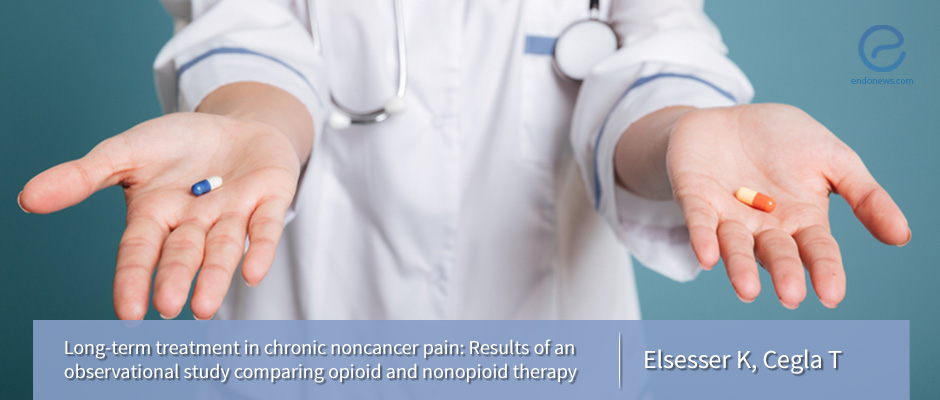Comparing opioid and nonopioid therapy for chronic pain
Aug 16, 2018
Whether opioids are superior to nonopioids even in the short-term, and whether long-term treatment with opioids is effective is still under debate.
Key Points
Highlights
- This study is the first to evaluate intermediate and long-term benefits of opioids for chronic pain in comparison to nonopioid treatment.
Importance
- Evidence shows significant pain reduction with opioids in the short term compared to placebo.
- Whether opioids are superior to nonopioids even in the short-term and whether long-term treatment with opioids is effective is still under debate.
What’s Done Here
- This was an observational study with a cross-sectional design.
- The study population included 333 patients which were assigned into two groups: The opioid analgesic group included patients with continuous opioid intake during at least the previous 3 months. The nonopioid analgesic group included patients treated with different kinds of analgesics but had not received opioids in the previous three months.
- The diagnosis was obtained through medical records.
- Patients provided information about the duration of their pain and use of analgesic medication, name and dose of current and previously taken analgesics, adverse effects, and satisfaction with the current medication in a semi-structured interview.
- The German Pain Questionnaire was used to collect information pain intensity.
- The Chronic Pain Grade (CPG) scale was used to collect information about pain severity and disability.
- Quality of life (QoL) was assessed through the WHOQoL-BREF questionnaire, general wellbeing through the Marburg Questionnaire on Habitual Health, and depression and anxiety through the Hospital Anxiety and Depression Scale (HADS).
- Statistical analysis was performed to analyze the data.
Key Results
- No clear advantage of opioid vs. non-opioid analgesics could be revealed.
- In the low to medium opioid dose range, the benefit to risk relationship is reasonable and opioid use seems to be justifiable. However, increasing the opioid dose to meet the patient requirements does not deliver additional benefits.
- Both opioid and non-opioid analgesics are an important therapeutic option but appear to be inadequate for long-term management of chronic pain.
Limitations of the Study
- Observational studies are determined by clinical practice and not by the study protocol, thereby leaving uncertainty about alternative explanations for the study results.
- Due to the cross-sectional design of the study, temporal relationships between treatment and outcome are difficult to determine.
Lay Summary
Over the last few decades, North-America and Europe show continued increase in prescription rates of opioids. Evidence shows significant pain reduction with opioids in the short term compared to placebo, however whether opioids are superior to non-opioids even in the short-term and whether long-term treatment with opioids is effective is still under debate. Therefore, researchers from Germany investigated the long-term benefits of opioid analgesics (OA group) for chronic pain in comparison to nonopioid non-opioid analgesics (NOA group).
Findings showed that analgesic prescription and intake was mainly due to disorders of the musculoskeletal system and other somatic disorders. The OA group had significantly longer duration of pain, longer time of analgesic intake, and higher scores on a neuropathic pain scale. Both groups reported similar duration of continuous NOA intake for approximately three years. Use of opioids in the OA group was at an average time of intake of about 3 years.
The two groups did not show significant differences in pain intensity and disability, and a rather high degree of continuous pain throughout the last month was reported by both groups. Approximately 80% of the patients felt highly disabled and severely limited due to their pain disorder. The authors report that “these observations raise questions about the long-term effectiveness of analgesic treatment regimens irrespective of analgesic type employed”. They also advise “more frequent reviews of the effectiveness of analgesic therapy and appropriate treatment changes”.
Furthermore, more adverse effects were observed in the OA group compared to the NOA group. Wellbeing, disability scores, and physical quality of life (QoL) were reported to be more impaired in the OA group compared to the NOA group.
In terms of satisfaction with medication, no differences were observed between the groups. More importantly, an association between dosage and level of satisfaction with medication was not observed and improvement of pain, QoL or other indicators of psychological wellbeing and functioning were not achieved by increasing the opioid dose.
A positive correlation was observed between depression scores and higher opioid doses. The authors highlight that “the direction of this association is under discussion, with some evidence supporting mental health problems as an antecedent condition”.
The authors conclude by stating that although both opioids and nonopioids remain an important therapeutic option for patients with chronic pain, the evidence from this study shows that they are inadequate for long-term management due to the level of impairment and poor QoL experienced by patients. In addition, they note that although a low to medium opioid dose range has a reasonable benefit to risk relationship, increasing to higher doses does not deliver additional benefits. They suggest that “long-term treatment requires a meaningful therapy plan and a combination of different treatment modules with activating physical therapy and psychological pain management as essential ingredients”.
Research Source: https://www.ncbi.nlm.nih.gov/pubmed/?term=28850379
Long-term opioid therapy Chronic pain Quality of life Functional outcome Psychological wellbeing

